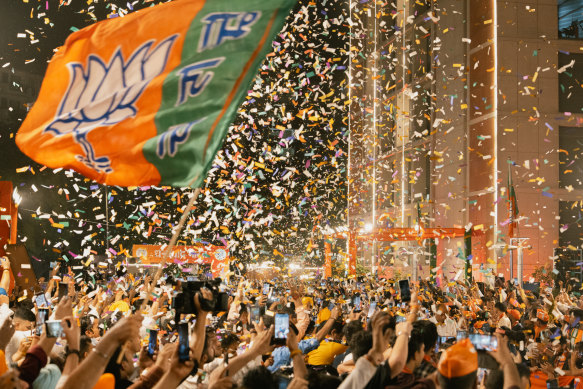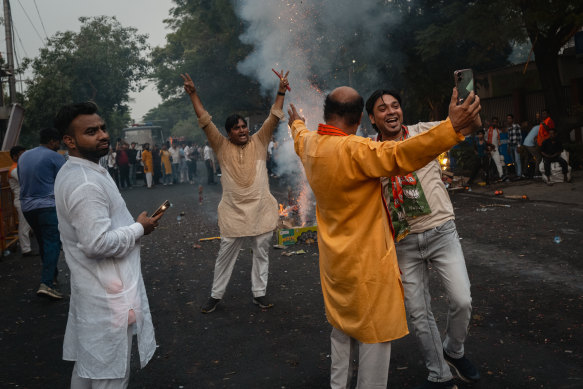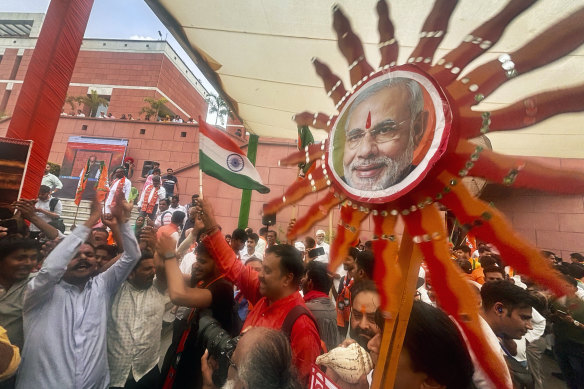
“Modi is not known as a consensual figure. However, he is very pragmatic,” said Arati Jerath, a political analyst based in New Delhi. “He will have to moderate his hard-line Hindunationalist approach to issues. Perhaps we can hope for more moderation from him.”
Loading
Few doubt, however, that Modi will try to deepen his already considerable imprint on the country over the next five years.
On his watch, India, the world’s most populous nation, has enjoyed newfound prominence on the global stage, overhauled its infrastructure for the needs of its 1.4 billion people, and been imbued with a new sense of ambition as it tries to shed the legacy of its long colonial past.
At the same time, he has worked to turn a vastly diverse country held together by a secular democratic system into an overtly Hindu-first state, marginalising the country’s large Muslim minority.
His increasingly authoritarian turn – with a crackdown on dissent that has created a chilling environment of self-censorship – has pushed India’s vociferous democracy closer to a one-party state, his critics say. And the country’s economic growth, while rapid, has mostly enriched those at the top.
Modi rose from a humble background as the son of a tea seller, becoming India’s most powerful and popular leader in decades by building a cult of personality, spending big on infrastructure and welfare, and tilting India’s democratic institutions in his favour.

A huge crowd turned out to hear Narendra Modi speak.Credit: Getty
The ultimate goal was to cement his standing as one of the most consequential prime ministers in the country’s nearly 75 years as a republic and make the BJP its only plausible national governing force.
But the election results pointed to a turnaround for the beleaguered main opposition party, the Indian National Congress, which had been seen by many as irrevocably weakened after big losses in the previous two elections.
The once-dominant Congress, long positioned at the political centre, struggled for years to find a direction and offer an ideological alternative to the BJP. But it and its coalition partners found traction in this election by attacking Modi’s government over issues like unemployment, social justice and the prime minister’s ties to India’s billionaires.
Loading
Last year, as Rahul Gandhi, 53, the public face of the Congress party, sought to burnish his standing by leading long marches across India, the BJP ensnared him in a court case that led to his expulsion from parliament. He was later returned to his seat by India’s highest court and was set to win re-election.
Exit polls released on Saturday, after more than six weeks of voting in the world’s largest democratic exercise, indicated that Modi’s party was headed toward an easy victory. But there had been signs during the campaign that Modi was worried about the outcome.
He crisscrossed the country for more than 200 rallies over about two months and gave dozens of interviews, hoping to use his charismatic appeal to paper over any weaknesses in his party. In speeches, he often veered from his party’s message of a rising India to counter accusations that he privileged business and caste elites. He also abandoned his once-subtle dog whistles targeting India’s 200 million Muslims – instead demonising them directly, by name.
The BJP won 240 seats on its own, 32 short of the 272 needed for outright majority in the 543-member decision-making lower house, according to official results. Modi was set to meet his allies on Wednesday to discuss forming government.
Two regional parties in particular would be kingmakers: the Telugu Desam Party, in the southern state of Andhra Pradesh, with 16 seats, and the Janata Dal (United) party in the eastern state of Bihar, with 12.

Supporters of Indian Prime Minister Narendra Modi celebrate in a New Delhi street.Credit: Getty
Both parties are avowedly secular, raising hopes among Modi’s opponents that their influence could slow down his race to turn India’s democracy into a Hindu-first state.
Some of Modi’s biggest losses came in the most populous state, Uttar Pradesh in the north, with about 240 million people. His party leads the state government and had won 62 of the state’s 80 seats in the national parliament’s lower house in the previous election, in 2019.
As counting entered its last stretch in the evening on Tuesday, the BJP was leading in only 33 seats there. In his own constituency, Varanasi, his victory margin was reduced from 500,000 last time to about 150,000.
Modi broke some new ground in Kerala, a state dominated by the political left and long hostile to his ideology. But overall in the south, he struggled to improve on the 29 seats, out of 129, that his party had won in the previous election.

Bharatiya Janata Party (BJP) supporters dance inside the party office on Tuesday.Credit: AP
Perhaps the biggest disappointment for the BJP in southern India was that it once again appeared not to have won any of the 40 seats in Tamil Nadu, a state with its own strong cultural and linguistic identity.
Modi had campaigned aggressively there, even visiting one coastal town for two days of meditation as the voting neared its conclusion.



























